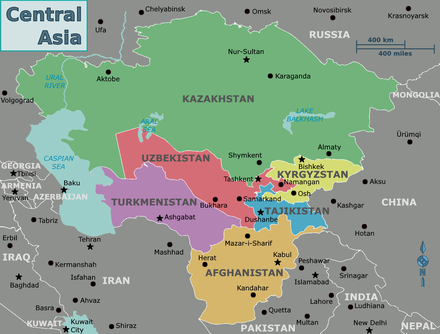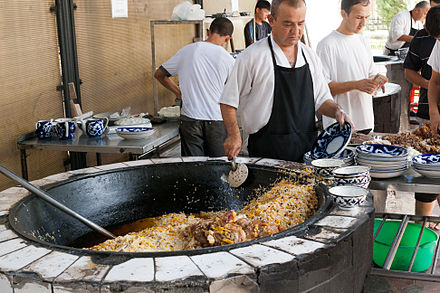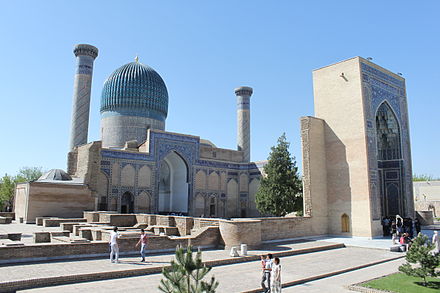Central Asia - subregion of the Asian continent
Central Asia is a rugged, arid region, historically coveted for its position between Europe and East Asia with the legendary Silk Route, rather than for its resources, although petroleum, natural gas, and mineral reserves have become more important in modern times.
The region has no exact boundaries, but is usually considered to include all of the landlocked "-stans", listed below. All but Afghanistan, (which is sometimes categorized separately) are former Soviet republics, most of which have so far have retained authoritarian, secular governments. They are home to generally poor, primarily Muslim peoples, mostly speaking various Turkic languages. Several of the peoples were historically nomadic.
Countries

One-time backpacker Shangri-La, but bloody war, famine, and nightmare politics since the late 1970s have left it with considerably less appeal for travellers.
The world's largest landlocked nation is sparsely populated, dominated by archetypal Central Asian steppe, with deep reserves of fossil fuels, and pockets of beautiful wilderness for outdoors enthusiasts.
A truly beautiful country high in the mountains, and with the exception of the admittedly fascinating but unsafe Ferghana Valley, Central Asia's easiest and perhaps most pleasant place to visit.
Central Asia's poorest backwater truly is off the beaten path, but has some incredible landscapes and Persian culture nonetheless.
An amalgam of desert moonscapes and arid mountains, dotted with the ruins of great ancient civilizations, and ruled until 2006 by a post-Soviet lunatic cultivating one of the most bizarre cults of personality in history, this is off-the-beaten-path, difficult (courtesy of rotten officialdom), but potentially very rewarding travel.
With cities such as Samarkand, Bukhara, Khiva, Tashkent, and other old Silk Road citadels, this country has way more than its fair share of culture and history. The people are warm and friendly and the country naturally is nothing short of beautiful.
Much of Central Asia was once ruled by the Persian Empire and some definitions of the region would include Persia, now called Iran. Various other regions — Mongolia, Western China (Inner Mongolia, Xinjiang, Gansu, Qinghai, Ningxia), and parts of Russia (Buryatia, Chuvashia, Tatarstan, Bashkortostan, Tuva, Altai, Khakassia) — have cultures that are largely Central Asian and are sometimes included as well.
Cities
- Almaty — Kazakhstan's former capital is an infinitely more preferable destination than ad hoc Astana.
- Ashgabat — Turkmenistan's capital, with weird dictator monuments galore and natural gas wealth ostentation.
- Astana — Kazakhstan's dreary, cold northern capital.
- Bishkek — the leafy and drowsy capital of Kyrgyzstan.
- Bukhara — a 2,500-year-old Silk Road city in Uzbekistan and UNESCO World Heritage Site.
- Dushanbe — the sleepiest Central Asian capital by leagues in Tajikistan.
- Kabul — Afghanistan's capital and hub for, well, anyone who has to go to Afghanistan.
- Samarkand — another of Uzbekistan's world-famous 2,500-year-old Silk Road cities, and also another UNESCO World Heritage Site.
- Tashkent — Uzbekistan's capital, whose ages-old history lies below Soviet-era construction, and by far the region's biggest city, at some 3 million.
Other destinations
.jpg/440px-Merv_(3891847139).jpg)
- Aral Sea — a post-apocalyptic ecological disaster area of a dead sea, filled with the empty husks of overturned rusting boats and seashells that once moved with life in this now dead region.
- Band-e Amir — the breath-taking sight of five torquoise-blue lakes, connected by waterfalls, surrounded by barren wasteland in Afghanistan.
- Chimbulak — Central Asia's most accessible ski resort (no helicopters needed), outside Almaty.
- Darvaza— simultaneously Central Asia's strangest and most jaw-dropping attraction, the Gates of Hell is a vast flaming crater hundreds of miles from civilization in the middle of the inhospitable Karakarum Desert.
- Issyk Kul — an absolutely gorgeous alpine lake, and perhaps Central Asia's most iconic natural wonder.
- Merv — the most famous of Turkmenistan's many ruined medieval Silk Road cities.
- Nissa — ruined Parthian fortresses comprising a UNESCO World Heritage site within easy striking distance of Ashgabat.
- Zeravshan Valley — a rugged and beautiful section of Tajikistan in the trekking and climbing-friendly Fan Mountains.
There are two regions that were historically important and are culturally coherent but today are divided among several countries:
- Ferghana Valley - the main Silk Road route from China into Central Asia
- Bactria - on the main trade route from Central Asia to Afghanistan and the Indian subcontinent
Understand
Central Asia is an area that was, until the late 20th century, inaccessible for independent travellers. That has all changed, although the traveller will still often come up against a wall of Soviet-style bureaucracy. Corruption is also an issue in most Central Asian countries. Despite this, Central Asia is increasing in popularity amongst travellers who want to experience one of the world's last great frontier lands, and the strong Islamic tradition of hospitality means that you will likely be treated as a revered guest by the locals, particularly in rural areas.
History
See also: Persian Empire
Historically and geographically diverse, Central Asia is an interesting region. At one time large parts of it were part of the old Persian Empire and were taken by Alexander the Great when he conquered that empire. Later, parts of it were ruled by Alexander's successors or by newer versions of the Persian Empire.
As a bridge between Europe and Asia, the region was the home of the Silk Road, the ancient trading route between the two continents from a few centuries BCE until it was mainly replaced by sea routes after 1500 CE. The area has seen much upheaval and conflict, from the expansion of Islam to the destructive Mongol invasion. By the end of the 19th century, most of the region had been conquered by the Russian Empire, with only Afghanistan remaining independent as a buffer state between the British Empire in India and the Russian Empire. This period of intense competition between the British and Russian Empires in the region is often referred to as the Great Game.
Following the Russian revolutions that brought down the Russian Empire in 1917, the parts of Central Asia that had been conquered by the Russian Empire became part of its successor state the Soviet Union. Afghanistan remained independent but went through a turbulent history, resisting a Soviet invasion throughout the 1980s, then was taken over by the radical Islamist Taliban, then invaded by a US-led coalition. Many Soviet citizens (including Ukrainians and Koreans) settled in Central Asia's Soviet republics, with Baikonur as centre of the Soviet and Russian space program, and Semipalatinsk as a nuclear test site. With the collapse of the Soviet Union in 1991, the Soviet republics in Central Asia gained their independence, but have maintained close political and economic ties with Russia since their independence, with Russian remaining the most common second language, and significant ethnic Russian minorities. However, China is rapidly expanding its influence through large infrastructure projects in the region as part of its Belt and Road initiative. Although the former Soviet republics in Central Asia have a Muslim majority, due to the fact that religion was heavily suppressed by the communist Soviet government, they tend to be more secular and relaxed in their religious observances than Muslims in the Middle East, though the Islamic tradition of hospitality is still very much alive.
Population increase and modernization have taken its toll on the environment. Central Asia is dependent on a few water sources, some of which, especially the Aral Sea, are near depletion.
Some Central Asian countries are beginning to find their feet and offer good travelling options. There are parts of Central Asia that have hardly seen a traveller before, and there are many wild and beautiful landscapes to be explored. That is not to say the region is bereft of problems, chiefly a lack of infrastructure and stifling bureaucracy.
People
Understand that self-identification is an especially touchy issue in Central Asia, more so than most of Europe. Parts of China (Notably Tibet and Xinjiang) have a native population that has in many instances advocated for secession from China. Often they emphasise their Central Asian identity, something not well-understood by outsiders. For example, Mongolians and Buryats tend to emphasise their historical ties with the Turkic Muslims to the west (despite being Mongolic Buddhists of the Tibetan Rite) and are offended by being compared to the Chinese, and some even call themselves Europeans (by virtue of Russian influence).
This situation is not unique to Mongolic peoples; Tibetans are well known in the West for their disdain for China and any ties they may have to it. Many people in Tatarstan and Xinjiang, among other places, would emphasise their Turkicness over any connection to China or Russia.
The problem goes the other way as well. Many Chinese are quick to point out that the Qing Dynasty (and the earlier Tang and Han Dynasties) controlled parts of Central Asia, including some land no longer controlled by the Chinese.
From Kyrgyz to Tibetans, a history of tribal politics have left Central Asia at once totally isolated from the outside world, and intimately connected to whoever conquered them.
Talk
Much of Central Asia speaks a language from either the Iranic, Turkic and Mongolic language groups, often influencing each other.
- Turkic languages are Uzbek in Uzbekistan and Tajikistan, Kazakh in Kazakhstan, Kyrgyz in Kyrgyzstan and Turkmen in Turkmenistan.
- Iranic languages belong to the Indo-European language family. Persian is spoken in Iran, with Dari and Pashto being the dominant languages of Afghanistan. Tajik is spoken in Tajikistan.
- Mongolic languages are scattered across the region, from Mongolia and Inner Mongolia (in China), to Buryatia and Kalmykia (in Russia).
With the exception of Afghanistan, Russian is widely spoken in the countries of Central Asia due to their history as part of the Soviet Union
Get in
As mentioned above, the definition of "Central Asia" can be controversial. One reason why the one used on this page is useful, however, is visas.
All Central Asian countries except for Kyrgyzstan require visa for visitors from a lot of countries, and the difficulty of getting them may range from a minor hassle to virtually impossible if not on a tour or with a guide. Before issuing a visa, some countries will require a letter of invitation, often best obtained via a specialist travel agency. Some hotels will issue letters of invitation for confirmed reservations. Some nationalities may be excluded from the requirement to have one at all. Start working on your visas well in advance, as it may take weeks for the gears of bureaucracy to grind through your application, and make sure you comply with any local police/bureaucracy registration requirements after you've arrived.
By plane
_AN1593528.jpg/440px-Bishkek_-_Manas_(FRU_-_UAFM)_AN1593528.jpg) The hub for the region is Tashkent, Uzbekistan, which has the most flights to destinations outside Central Asia. Unfortunately the airport also has a reputation for being unpleasant, and it is best to avoid flights which arrive here late at night.
The hub for the region is Tashkent, Uzbekistan, which has the most flights to destinations outside Central Asia. Unfortunately the airport also has a reputation for being unpleasant, and it is best to avoid flights which arrive here late at night.
There are also increasingly good options for flights to Almaty, Kazakhstan. You can fly here directly from London, Frankfurt, Beijing, Seoul, Moscow, Riga and various others.
Most Afghans and Pakistanis travel by air to Islamabad or Lahore and go by road to their final destinations.
To arrive in other Central Asia cities will generally require a transfer in one of these hubs. The cheapest flights from Europe in 2014 could be found to Osh starting at €400 for return flights.
Overland
From Russia
.jpg/440px-Train_ride_from_Astana_(4055604094).jpg) Trains going to Central Asia leave from Moscow Kazansky station. Trains go to Tashkent (56 hours/US$80), Almaty (78 hours/US$120), Bishkek (75 hours/US$70), Samarkand (85 hours/US$100), and others.
Trains going to Central Asia leave from Moscow Kazansky station. Trains go to Tashkent (56 hours/US$80), Almaty (78 hours/US$120), Bishkek (75 hours/US$70), Samarkand (85 hours/US$100), and others.
From China
There is a line from Urumqi, China to Almaty, but the bus is quicker. An interesting option is the challenging crossing from Kashgar, China to Kyrgyzstan through the Torugart Pass. This was a major link on the old Silk Road.
From Iran
The border is closed to foreigners, but there are buses running between Mashhad and Ashgabat, Turkmenistan.
From Pakistan
Travelling to different areas of Pakistan is quite easy by train, bus or taxi. The route from there into Afghanistan via the Khyber Pass is not safe. The Karakoram Highway North into China is challenging but possible. It gets you to Kashgar; from there routes to Central Asia are either difficult (West to Bishkek) or long (swing North to Urumqi and then Almaty).
By boat
There is an irregular service between Baku, Azerbaijan and Turkmenbashi, Turkmenistan.
Get around
Getting between Central Asian countries is tricky. It used to be practically impossible to get into Turkmenistan. Get as many visas as you can before you leave. If not, make sure you're "stationed" in one and have time to deal with the bureaucracy at each embassy before you go.
See
.jpg/440px-Taldyk_pass_(3600_m).jpg) The whole region is filled with steppes and mountains, beautiful scenery that has served as the backdrop for a half-dozen empires. Most tourists to the region arrive in one of the capitals and immediately book a tour of the mountains or countryside (especially in Kyrgyzstan).
The whole region is filled with steppes and mountains, beautiful scenery that has served as the backdrop for a half-dozen empires. Most tourists to the region arrive in one of the capitals and immediately book a tour of the mountains or countryside (especially in Kyrgyzstan).
The Western Tien-Shan mountain range in Kazakhstan, Kyrgyzstan and Uzbekistan is listed as a world heritage site.
Itineraries
- Europe to South Asia over land
- Istanbul to New Delhi over land
- On the trail of Marco Polo
- Moscow to Urumqi
- Silk Road
- Sven Hedin's voyages
The Trans-Siberian Railway passes a bit north of this area. In addition there are some other named Russian-built railways from the late 19th and early 20th century, all meeting near Tashkent:
- The Trans-Aral railway goes from Orenburg in Russia (at the border between Europe and Asia) southeast across Kazakhstan; in the southern end the Turkestan-Siberia railway branches off to the east before the railway crosses into Uzbekistan and ends in its capital Tashkent.
- The Trans-Caspian railway begins in Turkmenbashi at the eastern shore of the Caspian sea, goes through the length of Turkmenistan, passing the capital Ashgabad, Mary, and Turkmenabad. Then the railway continues into Uzbekistan passing Bukhara and Samarkand before arriving in Tashkent.
- The Turkestan-Siberia railway: goes from Arys in Kazakhstan north of Tashkent to Shymkent and across southern and eastern Kazakhstan to Almaty and on to Barnaul and Novosibirsk in Siberia.
Do
With its vast nature and harsh seasonal differences, Central Asia is a challenging destination for outdoor life.
Buy
Central Asia is a relatively cheap destination for western standards, but more expensive than e.g. Southeast Asia. A decent meal costs around US$5, a beer about US$1. A comfortable double room is about US$30-60. Expect to pay higher prices in the big cities. The region is famous for its carpets.
Eat
 The cuisine of the region has been influenced by the Russian cuisine, Middle Eastern cuisine and Chinese cuisine.
The cuisine of the region has been influenced by the Russian cuisine, Middle Eastern cuisine and Chinese cuisine.
The further south you are, the more flavourful the cuisine is. Afghanistan and Tajikistan have far different cuisine than the Mongolic or Turkic cuisines, which are mostly hearty, spice-free, meaty fare.
All Central Asian countries are heavily carnivorous. There are local vegetarians in all Central Asian countries (even Afghanistan) but they are in the minority. This means while you can go without meat and survive, you will attract odd looks.
Drink
Except Afghanistan and northern Pakistan, alcohol is not uncommon to drink in Central Asia. However, tea still remains the region's favorite beverage. In some countries, green tea is customarily consumed all throughout the day.
The nightlife scene is almost nonexistent in Central Asia. While the region is not the world's number one destination for clubbing, the Russophone party culture ensures a good time in places like Bishkek, Almaty, and Tashkent.
Stay safe
Safety in Central Asia is a complex issue. While Afghanistan is notable for a high risk of kidnappings, terrorism, and the Taliban resurgence, most other Central Asian countries risk riots after years of autocratic or near-autocratic government. Kyrgyzstan suffered through a violent revolution in 2010. In more stable areas, corruption and authority misconduct are more of a threat.
This is not to say that the entire region is a death trap. Most of the time, parts of the region are actually quite peaceful. But even then you may have some issues. Most likely for the tourist is having one's pocket picked. See each individual country for a more complete summary.

